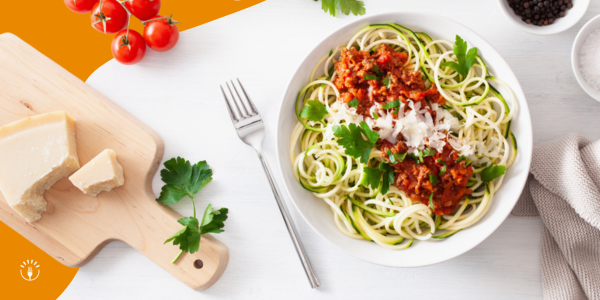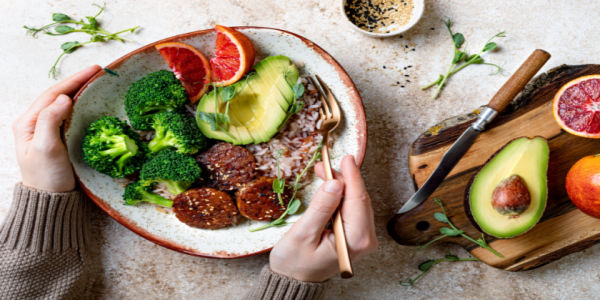
Eating healthier may sound daunting, especially when you have many changes to make. Instead of making too many shifts at once, starting with small and simple steps is often more effective.
Healthier food swaps can be a less intimidating way to start introducing more healthy habits into your life, no matter what stage of your health journey. Whether you want to lose weight or eat a bit healthier, check out these healthy food swaps.
Healthy Food Swaps: Small Tweaks, Huge Health Results
The motivation to eat healthier can create pressure to immediately change all the “problem areas” of your diet. But truly changing your diet often comes down to minor tweaks you can sustain over time.
Just as bad habits can be built over time, sound habits can take hold over time to create positive results. Instead of developing disease or raising your risk for chronic disorders over time, you can incrementally make yourself healthier.
Even just one swap a day can make a difference! The little, everyday choices you make can result in meaningful habits formed. In other words, small swaps can add up to big benefits, especially when providing health benefits through your diet.
The key is to find foods you already eat and switch them out for slightly healthier ingredients. Before you know it, you’ll follow a healthy diet that feels effortless since you made minor tweaks one at a time instead of massive changes.
Instead of making too many changes simultaneously, focus on making one healthy swap at a time. Not only are these swaps quick and easy, but they are more likely to stick than if you overhaul your all at once.
Fruit for Fruit Juice
While fruit juice can certainly fit into a healthy diet and provide some vitamins and minerals, whole, fresh fruit is considered the absolute nutritional powerhouse; it contains heart- and gut-healthy nutrients and provides the fiber juices lack.
If you’re hesitant to switch from fruit juice to fresh fruit, start with a smoothie or fruit salad that contains a mix of fresh fruits (such as berries and bananas). Canned or frozen fruit can count towards your daily recommendation if you find it difficult to locate fresh options in your area— just be sure they are packaged in their own juices or water (as opposed to sugary syrups).
Dark Leafy Greens for Lettuce
Generally, when it comes to greens, the darker the better! Instead of lighter-colored lettuces (like icebergs), opt for dark leafy greens, such as spinach, kale, or arugula. These options contain more vitamins and minerals on average and are well-suited to many cooking styles.
Sparkling Water for Soda
A soda habit can be hard to kick, but not impossible. Try sparkling water to make the switch from sugary drinks to better beverages easier! The carbonation can give you the mouthfeel you crave but at a fraction of the calories.
Plus, just like regular water, it can be infused with fresh fruit for a more exciting look and flavor (and a few added nutrients).
Dark Chocolate for Milk Chocolate
Although dark chocolate still has sugar, fat, and calories like its milky counterpart, it contains more cocoa—the raw ingredient of chocolate. Cocoa contains flavanols, a special plant chemical occurring naturally in fruits and vegetables, linked to numerous health benefits, such as heart health.
In essence, when compared to milk chocolate, dark chocolate is higher in vitamins, minerals, and antioxidants that the body needs for optimal daily function. Often, dark chocolate is lower in sugar, too.
Looking for 70% cocoa or higher on the label can help you optimize the health benefits of this tasty treat. You’ll also want to focus on portion size to stabilize calories and sugar.
Natural Sweeteners for Artificial or Processed Sugars
While the body still recognizes natural sweeteners like honey or maple syrup as sugar, they deliver marginally more nutrients—like vitamins, minerals, and antioxidants. Since options like maple syrup and coconut sugar rank lower than white sugar on the glycemic index, using them in smaller amounts to replace regular sugar in recipes may help to balance blood sugar.
Surprisingly, options like stevia (a plant-based, low-calorie sweetener), maple syrup, and honey taste sweeter than artificial sweeteners. You can use less of them, and your foods will still taste sweet. In other words, you won’t have to sacrifice your sweet tooth to stay healthy!
Sweet Potatoes for White Potatoes
Speaking of sugar, excessive intake of another carbohydrate is often to blame when it comes to sidetracking the diet and spiking blood sugars—starch. A common culprit from the vegetable family is potatoes. However, swapping sweet potatoes out for regular white potatoes can provide your body with some extra vitamins.
If your blood sugar is especially sensitive, it may be worth swapping potatoes for another vegetable! Cruciferous veggies—like broccoli or Brussels sprouts—are recommended for their fiber levels. Fiber is a type of carbohydrate that can actually stabilize your blood sugar and ultimately contribute to minimizing cravings for “unhealthy” foods.
Mashed Cauliflower for Mashed Potatoes
One exceptionally versatile cruciferous vegetable is cauliflower. It can masquerade as mashed potatoes when pureed, and with a dash of herbs and a drizzle of olive oil, you’ll hardly be able to tell the difference.
As an added benefit, mashed cauliflower is an extra serving of vegetables and is higher in specific vitamins and minerals.
Plant-Powered “Noodles” for Pasta
Another way to sneak some veggies in is using plant-based pasta instead of regular noodles. Pasta is often made from enriched or refined grains, which can add a lot of nutrient-depleted starch to the diet. Veggie-based noodles, on the other hand, are available in similar shapes but usually contain less carbohydrates and more vitamins and minerals.
Vegetables like spaghetti squash can naturally be turned into “noodle” shapes at home. A handy spiralizer can help you turn veggies like carrots, zucchini, sweet potatoes, and butternut squash into “noodles,” too.
Store-bought brands provide other types of plant pasta, using the following plant foods as a base:
• Broccoli
• Brown rice
• Cauliflower
• Chickpeas
• Edamame
• Lentils
• Peas
Whole Grains for Refined Grains
The old adage “make half your grains whole” is sound advice. Whether it be a snack or meal component, opting for whole or sprouted grains when possible is best.
Whole grains often add more nutrients—like fiber, vitamins, and minerals—and texture than refined products. For example, using whole-grain bread instead of white bread for sandwiches or toast can give you something a bit more textural to bite into.
This subtle switch can make a big difference in your health, and you may not even notice a difference in taste. Another example is using brown or wild rice instead of white rice in a rice bowl. It’s a subtle switch that provides added health benefits without affecting the overall flavor.
Corn Tortillas for Flour Tortillas
Although corn and flour tortillas have significant differences in taste and texture, it may be worth making the switch. They can be used interchangeably in most recipes, yet corn tortillas contain fewer calories than the average flour tortilla.
For recipes for better-suited flour tortillas (like burritos or chimichangas), seek out whole-wheat tortillas.
Salsa for Ketchup
Another swap inspired by Mexican cuisine is switching out salsa for ketchup. Even though it’s tomato-based, a closer look at the ketchup label usually reveals that the condiment is high in added sugars.
A less-processed alternative that provides a similar flavor profile and tomato-y taste is salsa. When made at home, you’ll have a handle on the ingredients, allowing you to customize aspects like spice level or the types of herbs and peppers thrown in.
Home-making your ketchup is also an option that will allow you to customize the ingredients to your dietary needs. It’s a little more labor-intensive but may be worth it for your health goals.
Heart-Healthy Oils for Saturated Fats
Butter can add a tasty element to meals, but using butter too much or too often can increase the amount of saturated fats in the diet (the “unhealthy” kind). Fats solid at room temperature, like butter or lard, can ultimately be bad for heart health and set the body up for health problems over time.
Luckily, certain liquid fats, like olive or avocado, are healthier and more versatile options that still provide plenty of flavor. Using them in small amounts daily and place of solid saturated fats can promote a healthier diet.
Plant-Based Proteins or Fish for Processed Meats
Along with taking a more plant-based route when using oils, opting for plant-based proteins also has heart-healthy benefits. Research shows that eating too much meat, particularly processed meats, may worsen health over time and increase the risk of chronic diseases like diabetes and cancer.
Alternatively, replacing red meat with hearty plant proteins can fill, fuel, and contribute to better health. In fact, a recent study suggests that athletes can thrive on primarily plant-based diets. Reducing animal protein intake may also help to quell inflammation in the body.
As with other healthy switches, look for options that closely resemble a food you’d usually eat, like black bean-based burgers or veggie burgers. If switching from processed meats straight to plant proteins doesn’t seem feasible, ease into it by substituting some of your red meat intake (like steak) with fish during the week. Options like salmon or tuna can be cooked similarly to other types of meat but boost your body’s levels of healthy fats like omega-3s.
Reduced or Low-Sodium for High Salt Foods
Another significant step to protect your heart is to keep an eye on salt intake. Salt, or sodium, is prevalent in Western diets and sneaks into salty and sweet foods.
Since too much salt can increase blood pressure and cause heart problems over time, it’s wise to look for low-salt alternatives. Many canned foods are available in low-sodium options for the same price, or you can simply experiment with different herbs, spices, and seasonings—such as lemon juice or garlic.
Low-Fat Dairy for Milk and Cheese
Another minuscule change that may make a big difference is opting for low-fat options when you purchase dairy, such as milk and cheese. Low-fat dairy contains less saturated fat than its regular or full-fat options while maintaining but maintaining many nutrients such as protein and calcium. Choosing low-fat varieties can contribute to lowering cholesterol.
Plant-based beverages are also an option, with soymilk providing the top protein among plant milk varieties. For those with dietary issues or dairy sensitivities, almond or other nut milk are also an option. These milk provide unique nutrient profiles and offer a nutty taste that can be utilized with everything from breakfast cereals to baking.
Greek Yogurt for Yogurt
Although often touted as a “healthy” breakfast food, fruity yogurts can have some of the highest amounts of sugar, making them more akin to dessert. Although pre-packaged fruit and yogurt parfaits may be fun, the mixes often contain more sugar than actual fruit, making them rich in calories but poor in nutrients.
For a genuinely filling breakfast (or snack any time of day), reach for Greek yogurt instead and add your own fresh fruit. This combo will keep you feeling full until your next meal and contains a fraction of the calories that pre-flavored varieties do.
Oatmeal or Muesli for Sugary Breakfast Cereal
A sugar crash doesn’t quite set the best tone for the day, especially regarding blood sugar. Instead of sugar-laden breakfast cereals, cereal grains like oats or muesli create a delicious morning meal with plenty of fiber and protein to sustain you throughout the AM hours. These nutrients also help to keep blood sugar levels balanced.
If you aren’t feeling oatmeal or muesli, whole-grain or shredded wheat cereals are another healthy option to swap your sugary cereals out.
Avocado or Banana of Toast or Bagel Toppings
As mentioned above, there are many delicious breakfast options, but not all set you up for healthy choices throughout the day. While it can be tempting to pile butter, cream cheese, or jam on top of your bagel or toast, these foods can worsen blood sugar levels and contribute to poor heart health if eaten excessively.
Instead, lean into the avocado toast trend by slicing or mashing avocado on top of your whole-grain toast or bagel. The avocado is a base for many delicious savory pairings, such as eggs, sesame seeds, herbs, olive oil, or tomatoes. Experiment until you find what you like best, secure in the knowledge that avocado’s healthy fats will keep you feeling full until your next meal.
If you have more of a sweet tooth, there’s a creamy yet healthy topping option for you, too. Try a mashed or sliced banana on top of your toast or bagel, along with a sprinkle of cinnamon.
Broth-Based Soups for Cream-Based Soups
Craving a soup for lunch but worried about the calorie count? Cream-based soups—like tomato basil or broccoli cheddar—typically contain more saturated fats, salt, and even sugar than broth-based ones.
Broth-based soups are generally lower in calories, help hydrate, and provide electrolytes to the diet. When shopping or selecting soups from a menu, consider broth-based options like minestrone, vegetable, or chickpea soups.
Lightly Salted Mixed Nuts for Chips
Salt often gets a bad rap, but you need some salt in your diet for your body to thrive. Instead of going overboard, look for lightly salted snacks with plenty of nutrients.
For example, swap chips for lightly salted or unsalted mixed nuts when you crave something salty. This will help calm your craving by providing healthy fats instead of saturated ones and nutrients like fiber and protein to keep you feeling full.
Bear in mind that a little bit goes a long way. Since nuts can still be high in calories, you’ll want to pay attention to portion size.
Healthy Food Swaps: Final Takeaways
The bottom line? Small swaps you can sustain over time can make a bigger difference than trying to redesign your diet all at once.
Start by looking at the foods you most frequently eat—like pizza or pasta—and see where you can make subtle changes without compromising on flavor—such as using a cauliflower crust or plant-based pasta.
Soon enough, you’ll see opportunities to substitute healthier foods everywhere you look, but it will feel effortless instead of overwhelming.






